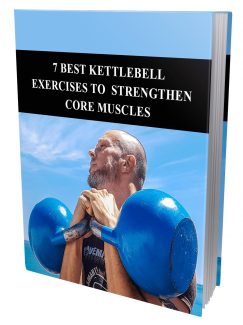 License Type: Master Resell Rights
License Type: Master Resell Rights  File Type: ZIP
File Type: ZIP
 SKU: 63232
SKU: 63232  Shipping: Online Download
Shipping: Online Download
Sample Content Preview
Introduction
Kettlebell exercises are perfect for improving core strength and enhancing the strength and flexibility of all related muscles extending outward to the extremities. The reason for this is the fact that the shape and movement of the kettlebell at the end of your arm/s keeps you off balance and more muscles are required to stabilize your body. Since the kettlebell is not stationary in your hands, it adds to the dynamics of each movement, forcing your muscles to compensate for the changing center of gravity.
Unlike most other weight training activities which isolate muscle groups, kettlebell workouts require the cooperative coordination of all the core muscles as well as those in the shoulders and back. You can control the intensity of the workout for losing weight or maintaining a good level of fitness all while conditioning and toning your core.
Some the things covered in the book include:
- What are kettlebells?
- History of The Kettlebell
- How they work
- Choosing Your Kettlebells
- Benefits of kettlebells
- Kettlebell Training for Men
- The Kettlebell’s Basic Techniques…and many more.
Kettlebells Explained
What Are Kettlebells?
Kettlebells are cannonballs or mini bowling balls with thick handles. As they are heavy in weight, they offer the benefits of dumbbell training while thick handles challenges grip resulting in enhanced muscle activity and working the body to the core.
How They Work
As weight of kettlebell hangs little below its handle, even regular movements require extra efforts. This extra muscle activity results in burning of calories, and thus reducing body fat especially in lower back area. Also, it involves use of multiple joints when kettlebell exercises are done targeting various body parts. Also, handles allow you to swing the kettlebells which pumps up the heart beats, resulting in cardio workouts. Research shows that a kettlebell workout burns at least 40 to 50 percent more calories than a standard strength-training workout.
Kettlebell exercises are dynamic and challenging, but it is advised that you build the routine slowly. First start with less weights and slow-motion exercises, and perform them in repetitions. As you get comfortable move towards advanced exercises that require more weight and speed.
Choosing Your Kettlebells
Weight
The nature of kettlebell workouts is quite different than that of barbells or dumbbells and the amount of weight used is also quite different. The free moving flow of kettlebell lifts and swings and the resulting changes in the center of gravity depend on the cooperative effort of many different muscles unlike those used simply for strength. Experience has shown that women tend to underestimate the kettlebell weight they can work with while men initially over-estimate.
For casual fitness routines, most women should start out with an 8kg or half a pood (18 lb.) weight (or just 4kg (8 lb.) if you are older or have been inactive for a while) and men with 16 kg, one pood (35 lb.) kettlebell. This depends on your overall fitness, comfort level and goals. As you become proficient or if you already are comfortable with such weight, you can progress to 12 kg (26 lb.), 16 kg (35 lb.), 20 kg (44 lb.) and 24 kg (53 lb.). The best way to determine the weight you should purchase is to attend classes or find an instructor so you can see what works best for you.
Adjustable weight kettlebells are also available but many experts suggest avoiding them in the interest of safety. Weight can be changed by adding or removing plates or filling/emptying sand or pebbles from inside the bell. Given the dynamic nature of kettlebell movements and the frequency of overhead positions, the chance of something falling on you is to be avoided. They can also be dangerous if the weight shifts within the bell and your grip and positioning has to change with every move.
Changing weights is not as important with kettlebell training as it is with barbells. With the same weight, you can increase the intensity of your workout with more reps, slower, increasing reps within a certain time period and the addition of more difficult routines. In effect, you can actually use the same kettlebell for years!
If you are interested in strength training, body building or competition, then progressing through increasing weight loads is important. Another option is to buy a second kettlebell of the same original weight for doubles training after you have become comfortable with the next one or two heavier bells.
Shape and Size
Kettlebells are frequently referred to as cannon balls with handles. While that is a fairly accurate description, there is a bit more to the construction of a quality kettlebell. The best bells are solid, one-piece construction made from a mold that includes the handle. A kettlebell with a handle that is welded on can have seams or ridges that cause irritation to your hands and may even break apart!
Two sides of a kettlebell are flat so that the bell can rest more comfortably against the forearm in the racked position. The bottom is also flat so the bell stays in place when set down. Lesser quality kettlebells are often not completely flat at the base and wobble during exercises that use the bell as a ground fixture such as push-ups.
Handles can be rounded or squared but should be large enough to accommodate your hand/s comfortably. There are some benefits to squared handles that form angles, but most instructors recommend curved or only somewhat flattened handles that can be gripped anywhere. Competition kettlebells have a slightly squared-off type of handle. The most important aspect of any handle, though, is its smooth connection to the bell.








